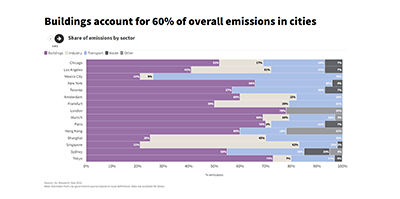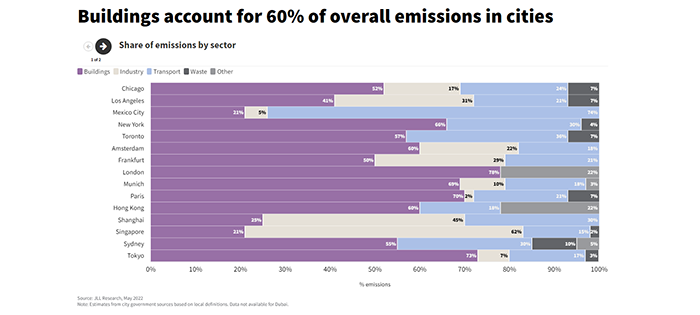
Decarbonizing Cities and Real Estate

City governments are setting rules to move to a net-zero economy. But their ambitious sustainability targets won’t be achieved without an active program to significantly reduce emissions from buildings, said JLL, Chicago.
“As city governments set more and more ambitious emissions targets, real estate landlords, investors, developers and occupiers will have a key role to play in delivering these targets,” JLL said in its Decarbonizing Cities and Real Estate report. “It is a group effort.”

JLL noted the real estate industry is under intense pressure to deliver a net-zero built environment. “Equally, expectations are high among real estate investors and occupiers about the role that city governments should be playing to drive the decarbonization agenda,” the report said. “City governments need to create the infrastructure, frameworks, laws and incentives for all stakeholders to be successful. They have a pivotal role in the drive to ‘green’ local energy grids, over which the real estate industry has little direct control, and they need to look beyond carbon and balance decarbonization goals with social equity, affordability, biodiversity and climate adaptation.”
JLL Global Head of Sustainability Services and ESG Guy Grainger called climate risk the biggest disruptor to established cities. “With a lack of funding or incentives from governments both locally and nationally, it is likely that the policy mechanism of choice will be to put more controls in place,” he said. “Investors, developers and occupiers should be prepared for regulators to use sticks, not carrots.”
Grainger noted more than 60 percent of carbon emissions within cities typically comes from buildings. “From New York City to Paris and Singapore, many cities now have a raft of targets and actions covering new and existing commercial and residential real estate,” he said. “While this momentum is to be applauded, it brings with it issues of its own; cities have different ways of measuring, reporting and regulating emissions. This makes for a very complex global landscape.”
Grainger said the report will help commercial real estate practitioners navigate the global landscape of real estate decarbonization by looking at the targets, regulations, reporting mechanisms, incentives, accelerators and collaborations across 32 global cities.
“By working together, all parties will be better able to bridge the gap between intent and action and make the best of this vital decade,” Grainger said. “Along the way, those cities with strong leadership to make tough early decisions will win in the medium term and those without the courage will fall behind in the race to a net-zero economy.”
